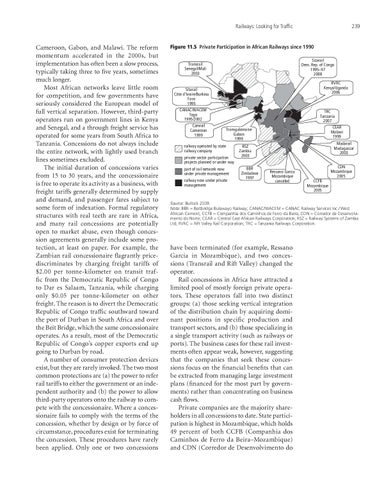Railways: Looking for Traffic
Cameroon, Gabon, and Malawi. The reform momentum accelerated in the 2000s, but implementation has often been a slow process, typically taking three to five years, sometimes much longer. Most African networks leave little room for competition, and few governments have seriously considered the European model of full vertical separation. However, third-party operators run on government lines in Kenya and Senegal, and a through freight service has operated for some years from South Africa to Tanzania. Concessions do not always include the entire network, with lightly used branch lines sometimes excluded. The initial duration of concessions varies from 15 to 30 years, and the concessionaire is free to operate its activity as a business, with freight tariffs generally determined by supply and demand, and passenger fares subject to some form of indexation. Formal regulatory structures with real teeth are rare in Africa, and many rail concessions are potentially open to market abuse, even though concession agreements generally include some protection, at least on paper. For example, the Zambian rail concessionaire flagrantly pricediscriminates by charging freight tariffs of $2.00 per tonne-kilometer on transit traffic from the Democratic Republic of Congo to Dar es Salaam, Tanzania, while charging only $0.05 per tonne-kilometer on other freight. The reason is to divert the Democratic Republic of Congo traffic southward toward the port of Durban in South Africa and over the Beit Bridge, which the same concessionaire operates. As a result, most of the Democratic Republic of Congo’s copper exports end up going to Durban by road. A number of consumer protection devices exist, but they are rarely invoked. The two most common protections are (a) the power to refer rail tariffs to either the government or an independent authority and (b) the power to allow third-party operators onto the railway to compete with the concessionaire. Where a concessionaire fails to comply with the terms of the concession, whether by design or by force of circumstance, procedures exist for terminating the concession. These procedures have rarely been applied. Only one or two concessions
239
Figure 11.5 Private Participation in African Railways since 1990 Sizarail Dem. Rep. of Congo 1995–97 2008
Transrail Senegal/Mali 2003
RVRC Kenya/Uganda 2006
Sitarail Côte d’Ivoire/Burkina Faso 1995 CANAC/WACEM Togo 1995/2002 Camrail Cameroon 1999
TRC Tanzania 2007 CEAR Malawi 1999
Transgabonaise Gabon 1999
railway operated by state railway company private sector participation projects planned or under way part of rail network now under private management railway now under private management
Madarail Madagascar 2003
RSZ Zambia 2003 BBR Zimbabwe 1997
Ressano Garcia Mozambique canceled
CDN Mozambique 2005 CCFB Mozambique 2005
Source: Bullock 2009. Note: BBR = Beitbridge Bulawayo Railway; CANAC/WACEM = CANAC Railway Services Inc./ West African Cement; CCFB = Companhia dos Caminhos de Ferro da Beira; CDN = Corredor de Desenvolvimento do Norte; CEAR = Central East African Railways Corporation; RSZ = Railway Systems of Zambia Ltd; RVRC = Rift Valley Rail Corporation; TRC = Tanzania Railways Corporation.
have been terminated (for example, Ressano Garcia in Mozambique), and two concessions (Transrail and Rift Valley) changed the operator. Rail concessions in Africa have attracted a limited pool of mostly foreign private operators. These operators fall into two distinct groups: (a) those seeking vertical integration of the distribution chain by acquiring dominant positions in specific production and transport sectors, and (b) those specializing in a single transport activity (such as railways or ports). The business cases for these rail investments often appear weak, however, suggesting that the companies that seek these concessions focus on the financial benefits that can be extracted from managing large investment plans (financed for the most part by governments) rather than concentrating on business cash flows. Private companies are the majority shareholders in all concessions to date. State participation is highest in Mozambique, which holds 49 percent of both CCFB (Companhia dos Caminhos de Ferro da Beira–Mozambique) and CDN (Corredor de Desenvolvimento do
